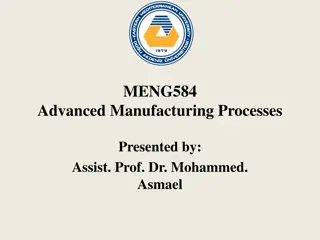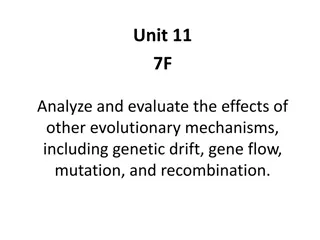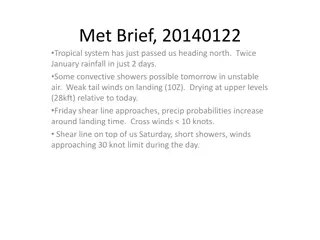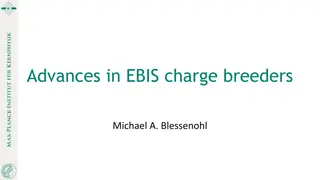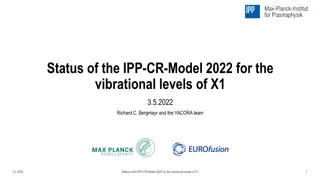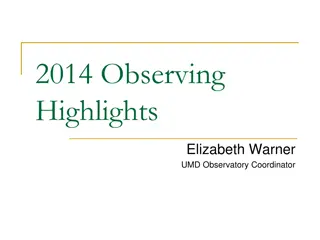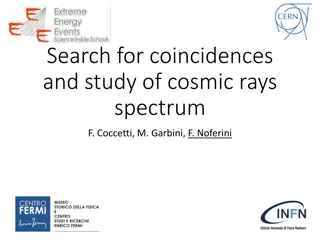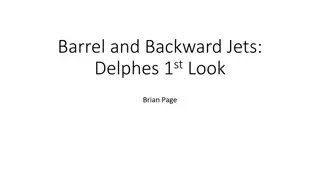Recombination in Jet Showers: Status and Discussion
This document discusses the status and ongoing research on recombination in jet showers, particularly focusing on the JET Collaboration Meeting at UC Davis in June 2014. Topics covered include in-medium hadronization, jet recombination formalism, application to in-medium shower Monte Carlos, challenges, advantages, progress in the JSR formalism, and baseline string fragmentation using PYTHIA. The goal is to complete realistic calculations of jet production in a high-energy density medium for comparison with experimental data.
Uploaded on Sep 14, 2024 | 1 Views
Download Presentation

Please find below an Image/Link to download the presentation.
The content on the website is provided AS IS for your information and personal use only. It may not be sold, licensed, or shared on other websites without obtaining consent from the author. Download presentation by click this link. If you encounter any issues during the download, it is possible that the publisher has removed the file from their server.
E N D
Presentation Transcript
JET Collaboration Meeting UC Davis, June 18, 2014 Recombination MC for Jet Showers: Status and Discussion Rainer Fries Texas A&M University With Kyongchol Han Che-Ming Ko JET Reco Working Group
Outline Reminder: In-medium hadronization The Jet Recombination Formalism Application to in-medium shower MCs Outlook and plans Other stuff Rainer Fries 2 JET 2014
Recombination in Jet Showers JET goal related to NSAC Performance Measures: Complete realistic calculations of jet production in a high energy density medium for comparison with experiment. (DM7) This includes chemical composition Well-established hadronization models for vacuum shower Monte-Carlo s Lund string fragmentation Cluster hadronization How to generalize to jets in a medium? Recombination: some early work on vacuum showers. [R. Migneron, M. E. Jones, K. E, Lassila, PLB 114, 189 (1983)] [R.C. Hwa and C.B. Yang, PRC 70, 024904 (2004); 024905 (2004)] Challenge: get vacuum fragmentation right. Advantage: medium effects are straight forward to implement; does well with heavy ion single particle spectra. Rainer Fries 3 JET 2014
Recombination in Jets Bulk hadronization: recombination is successful b/c of large phase space occupation. Jets: ~101 quarks+antiquarks in a narrow phase space volume; quarks in the jet bulk (small z) might be packed close enough to recombine. This situation will improve dramatically if the jet is in a medium. Isolated quarks (not in the jet bulk ): need to revert to strings Rainer Fries 4 JET 2014
Progress in the JSR Formalism Lots of feedback at the last collaboration meeting and at the Wayne State NLO/MC Meeting. Improvements: Full implementation of space-time information recombination through Wigner function overlap in phase space. Wigner function width fixed by hadron charge radii: reducing the number of unconstrained parameters. Improved treatment of non-perturbative gluon splitting Moved treatment of remnant partons from sampling of AKK fragmentation functions to string fragmentation. This is version number 1.0: paper has been written up. Rainer Fries 5 JET 2014
Baseline: String Fragmentation (PYTHIA) Perturbative PYTHIA parton showers evolved to a scale Q0. Standard PYTHIA Lund string fragmentation: Lund String String Decay Phenomenologically successful. Goal: reproduce main aspects of PYTHIA (string) hadron production with the recombination model. Rainer Fries 6 JET 2014
Formalism (I): Prepare Shower Perturbative PYTHIA parton showers evolved to a scale Q0. Decay gluons with remaining non- perturbative virtualities into quark- antiquark pairs. Force gluon decay Isotropic decay in the gluon restframe. Decay chemistry (only up, down, strange quarks) Rainer Fries 7 JET 2014
Formalism (I): Prepare Shower Example: Sample of 106 PYTHIA parton showers with Ejet = 100 GeV. dN/dz before vs after gluon decay Rainer Fries 8 JET 2014
Formalism (II): Recombination Use a Monte Carlo version of the instantaneous recombination model by Greco, Ko and Levai. Projection of partons onto meson and baryon states. Force gluon decay Equivalent to 2 1, 3 1 processes. Recombine Can be rewritten in terms of Wigner functions. Rainer Fries 9 JET 2014
Formalism (II): Recombination Meson and baryon yields: Meson and baryon Wigner functions: Shape from harmonic oscillator potentials Width from hadron charge radii WB Rainer Fries 10 JET 2014
Formalism (II): Recombination Quantum numbers treated statistically via statistical factors Charge radius from PDG Wigner function widths for stable particles Light resonance are important. Recombination probabilities evaluated in the hadron rest frame. Throw dice to determine actual recombination partners. Rainer Fries 11 JET 2014
Formalism (III): Remnant Strings Naturally there are remnant quarks and antiquarks which have not found a recombination partner. Why? No confinement in parton shower, quarks can get far away. Force gluon decay In reality: colored object needs to stay connected. Return these partons to PYTHIA to connect them with remnant strings. Recombine Remnant strings Rainer Fries 12 JET 2014
Formalism (III): Remnant Strings Bulk low-z quarks like to recombine. Lonely high-z quarks like to fragment. High z part of the jet guaranteed to hadronize as in the vacuum. Rainer Fries 13 JET 2014
Model Summary We replaced string fragmentation in the jet bulk by recombination. Standard PYTHIA Lund string fragmentation: Lund String Force gluon decay String Decay Our approach: Recombine Remnant strings String Decay Rainer Fries 14 JET 2014
Results and Comparison: Longitudinal Longitudinal structure: dN/dz of stable particles compared to PYTHIA string fragmentation. 100 GeV jets Rainer Fries 15 JET 2014
Results and Comparison: Transverse Transverse structure: Jet Broadening Little difference between PYTHIA parton and hadron (string fragmentation) showers. Our shower recombination reproduces PYTHIA results. 100 GeV light quark jets in e++e- Rainer Fries 16 JET 2014
Adding Medium Partons Sampling thermal partons from a blastwave models or hydro. Allow recombination of shower partons with thermal partons. Recombine Remnant strings Rainer Fries 17 JET 2014
Shower-Thermal Recombination Study with blast wave model to study the role of shower-thermal recombination. Here: Protons at LHC. Baryon production enhanced. Rainer Fries 18 JET 2014
Plans for the Near Future Applications to both the LBNL and WS shower MC are in the works. Common framework Shower medium effects restricted to T< Tc. Partons that stop evolution inside QGP have to be propagated to the critical hypersurface unless they thermalize. Hadronization applied to partons at T=Tc and T> Tc. Issues: Formation time after last splitting? Fate of recoiled medium partons. Rainer Fries 19 JET 2014
A Short List of Other Topics Open heavy flavor @ LHC: calculation of the TAMU framework with resonance recombination and non-perturbative Langevin transport. [M. He, RJF, R. Rapp, PLB (2014) in press] Color glass beyond boost-invariance. [S. Ozonder, RJF, PRC 89 (2014)] Using jets as trigger for photons from jet-medium interactions. [S. De, RJF, arXiv:1402.1568] Rainer Fries 20 JET 2014
Backup Rainer Fries 21 JET 2014
Why Quark Recombination? Data indicates a dependence of several important observables on the number of valence quarks. Quark coalescence models very successful for hadron production at intermediate PT in HICs. Large baryon/meson ratios Elliptic flow scaling with quark number QGP signature? Rainer Fries 22 JET 2014
Hadrons in Heavy Ion Collisions Proton/pion ratio RAA Intermediate momentum region in heavy ion collisions (2-8 GeV): No kinetic equilibrium Multi-particle dynamics No microscopic description of parton dynamics. Rainer Fries 23 JET 2014
Recombination in Equilibrium Realistic hadronization hypersurface : Extract equal-time quark phase space distributions fq along from hydro or kinetic model. Apply RRM cell-by-cell meson phase space distribution fM along . Compute meson current across a la Cooper-Frye: d d t = const. Result for charm-light system using AZHYDRO: [He, RJF & Rapp, 1106.6006 [nucl-th]] Rainer Fries 24 JET 2014











